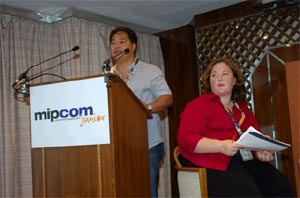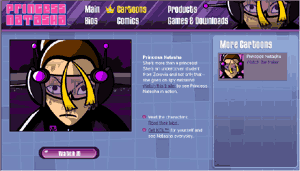
The multi-screen (Mobile, TV, Internet, PDAs etc) environment has not only created an abundance of ways in which entertainment can be consumed, but has also thrown open new vistas for content creators to explore.
While none of the emerging platforms have the combination of power, effectiveness and reach that television as a medium has, the increased delivery options are slowly but surely loosening the stranglehold that broadcasters traditionally have held over content creators and the creation process.
Session 1 on Day 1 of Mipcom Junior 2005 zoomed in on this emerging trend but with a focus on taking kids content beyond the tube. Panelists included: AOL Kids and Teens (US) Senior VP and GM Malcolm Bird, Virgin Atlantic Airways (UK) TV Acquisitions executive Emma Gesto, On Demand Media Group (USA) President Neil Goldberg, Lions Gate (US) Family Entertainment Executive VP Ken Katsumoto, and H3G (Italy) Marketing Manager Tiziano Tonti. The moderator: Kidscreen (Canada) Managing Editor Lana Castleman.
AOL’s Bird spoke about how KOL (Kids Online – AOL’s kids specific offering) was setting precedents in creating an online distribution model. He highlighted that the company had – and is – investing in creating original content specifically for KOL. “We have four animated shows, Princess Natasha, Skuuad, Kung Fu Academy, and Pila’s Adventures,” he pointed out.

In 2003 KOL launched Princess Natasha, a series of five minute flash animated cartoon (streaming). Within two years, the 3.5 million unique monthly visitors of KOL, had clocked close to four million sessions for Princess Natasha.
Created for the Internet, the popular cartoon has been licensed to several kids product manufacturers in the US and has now been licensed for broadcast to Cartoon Network (Europe). AOL also plans to release Princess Natasha for the home video segment.
Bird pointed out that Princess Natasha is a great example of successful content within the audiovisual realm, created specifically for the Internet, and now moving to other platforms including TV.
“Online can be used as an incubator for development of new properties by broadcasters” commented Bird.
Virgin Atlantic’s Emma Gesto spoke about the Airline’s original content strategy for in flight entertainment.
“We are probably the only airline to buy our programming directly from content creators rather than buying it from service providers. We have amongst our offering a dedicated pre school channel and we change our kids programming every six months. We even have a separate offering for babies”
Gesto pointed out that she had more freedom to experiment with titles, saying, “We just don’t look out for brands, we buy even lesser known titles as long as the programming fits in with our requirement.”
Content creators have great promotional opportunity with in flight entertainment as they can offer content related merchandise in flight, said Gesto.
Lion’s Gate Entertainment’s Katsumoto said that his distribution company comes in “when the creator has an IP and has automated processes with US broadcasters. We play the role of co-producers and marketers”
“The type of IP we look for has to be well known and has to be airing on major US broadcasters in US. Home Entertainment in US is controlled by the big retailers like Walmart (50 per cent), Target (29 per cent) and Best Buy (9 per cent) and taking into account that 80 per cent of the business comes from 20 per cent of the products, brands are important to us,” he said.
On Demand Group President Neil Goldberg commented on the growing demand for on demand.
“We are licensing specialists,” he said, adding, “We license content from across the board and build a large catalogue and deal with companies which have strong footholds in their regions.”
Is On demand restricted to TV? “Certainly not” was Goldberg’s reply. You already have on demand on the mobile and looking into the future we see lot of options like Download to the PC, Kiosks where content can be demanded and downloaded to memory sticks or other devices being used by consumers to access content when and how they like.”
H3G (Italy)’s Tonti confessed that his company did not yet have a focus on kid’s content but was being compelled to strategise on an offering for kids driven by recent statistics and research. Some of the startling statistics that Tonti shared were
Italy has the highest mobile penetration in the world (109 per cent)
56 per cent of kids aged between seven and eleven have a mobile phone
60 per cent of those kids use their mobile three hours a day
Amongst kids 40 per cent consumption is games and 30 per cent ringtones.
As the delivery horizons expand for kid’s content, the winds that are helping
content sail beyond the tube are that of ‘the need for differentiation and exclusivity’ hence original programming, ‘the need for comprehensive Value Addition’ hence localised and regional programming, ‘the need to cater to shorter and divided attention spans’ hence sachet programming.